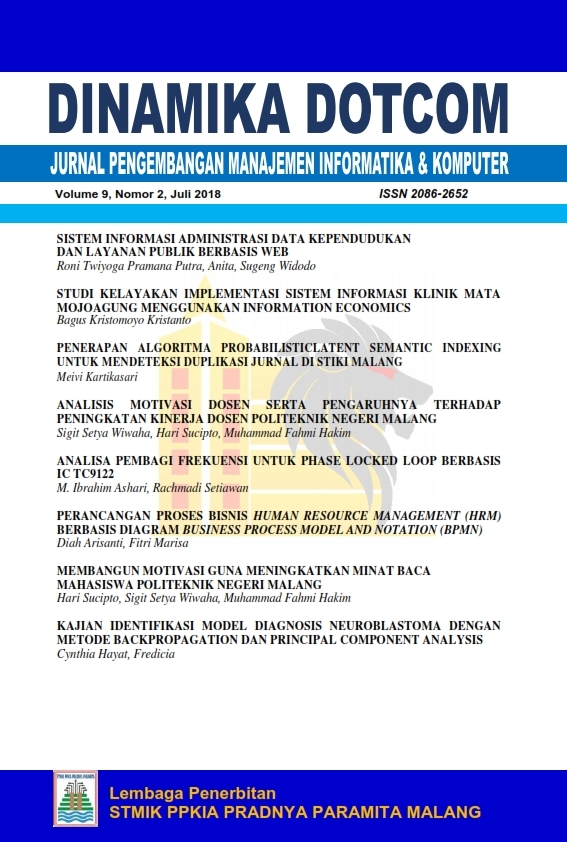KAJIAN IDENTIFIKASI MODEL DIAGNOSIS NEUROBLASTOMA DENGAN METODE BACKPROPAGATION DAN PRINCIPAL COMPONENT ANALYSIS
Abstract
Neuroblastoma is a type of embryonal cancer of the nervous system that is mostly found in children. Most etiologies of neuroblastoma are unknown, so many patients undergo treatment at an advanced stage. The importance of detection as early as possible is very necessary in neuroblastoma cancer so that children diagnosed with neuroblastoma can get a good prognosis. Through this study, it is expected to be able to know the feasibility of research with regard to artificial neural network procedures and the proposed PCA method. In this case the desired model is a set of training faces that will be formed through a linear combination in the training Propagation phase using backpropagation artificial neural network algorithms. In this case the desired model is a set of training faces that will be formed through a linear combination in the training Propagation phase using backpropagation artificial neural network algorithm. Backpropagation training by conducting feed-forward from input training patterns, calculations, related errors, and weighting settings based on previous weights
Keywords: literature study, identification, backpropagation, PCA
References
Howlader N, et al. (2012). SEER Cancer Statistics Review, 1975-2009 (Vintage 2009 Populations), National Cancer Institute. Bethesda, MD. -04-18]. Http://Seer. Cancer. …, 2009(April 2012), 2013. Retrieved from http://seer.cancer.gov/statfacts/html/pancreas.html#survival%5Cnhttp://scholar.google.com/scholar?hl=en&btnG=Search&q=intitle:SEER+Cancer+Statistics+Review,+1975-2009+(Vintage+2009+Populations),+National+Cancer+Institute.+Bethesda,+MD#0
Hecht-Nielsen, R. (1989). Theory of the Backpropagation Neural Network. Proceedings Of The International Joint Conference On Neural Networks, 1, 593–605. https://doi.org/10.1109/IJCNN.1989.118638
Kliegman, R. M., Stanton, B. F., Schor, N. F., St. Geme III, J. W., & Behrman, R. E. (2011). Nelson Textbook of. Edition 20 (p. 129). https://doi.org/10.1016/B978-1-4377-0755-7.00710-7
Elveren, E., & Yumusak, N. (2011). Tuberculosis disease diagnosis using artificial neural network trained with genetic algorithm. J Med Syst, 35, 329–32. https://doi.org/10.1007/s10916-009-9369-3
Amato, F., López, A., Peña-Méndez, E. M., Vaňhara, P., Hampl, A., & Havel, J. (2013). Artificial neural networks in medical diagnosis. Journal of Applied Biomedicine. University of South Bohemia. https://doi.org/10.2478/v10136-012-0031-x
Lisboa, P. J. G. (2002). A review of evidence of health benefit from artificial neural networks in medical intervention. Neural Networks, 15(1), 11–39. https://doi.org/10.1016/S0893-6080(01)00111-3
Textbook, N. (2016). Nelson Textbook of. Edition 20 (pp. 1557–1559; 2963). Elsevier.
Al-Shayea, Q. K. (2011). Artificial Neural Networks in Medical Diagnosis. IJCSI International Journal of Computer Science Issues ISSN, 8(2), 1694–814. https://doi.org/1694-0814
Bishop, C. M. (2006). Pattern Recognition and Machine Learning. Pattern Recognition (Vol. 4, p. 738). https://doi.org/10.1117/1.2819119
Puri, S., Vector, S., & Classifier, M. (2011). A Fuzzy Similarity Based Concept Mining Model for Text Classification. International Journal of Advanced Computer Science and Applications, 2(11), 115–121. Retrieved from http://www.getcited.org/pub/103499129
Er, O., Yumusak, N., & Temurtas, F. (2010). Chest diseases diagnosis using artificial neural networks. Expert Systems with Applications, 37(12), 7648–7655. https://doi.org/10.1016/j.eswa.2010.04.078
Gonzalez, R., & Woods, R. (2002). Digital image processing. Prentice Hall (p. 190). https://doi.org/10.1016/0734-189X(90)90171-Q


